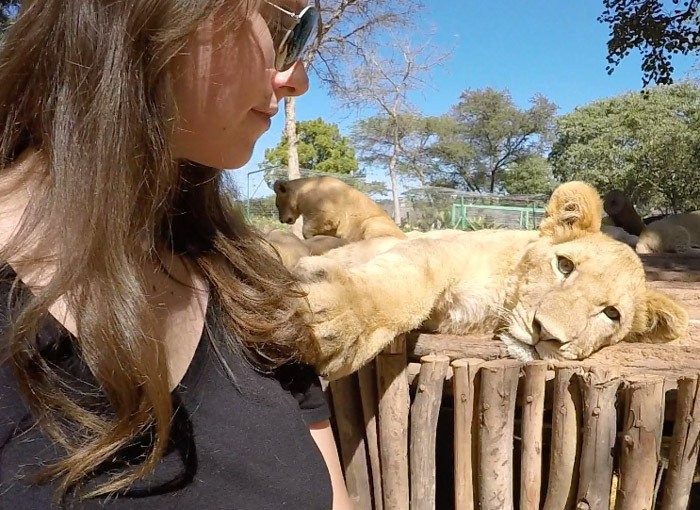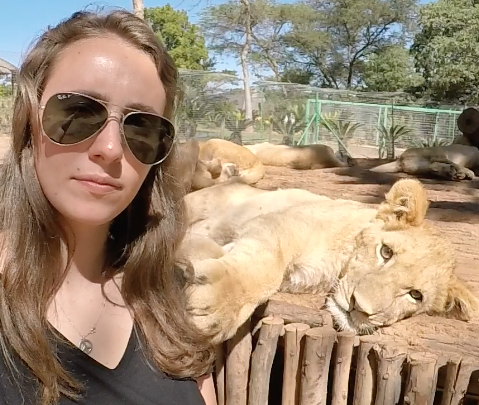As I apprehensively shuffled into the caged box, my stomach clenched, and my heart stopped. I immediately knew I was in a bad place and desperately wanted to run straight back out.
But something told me to carry on; something told me that by enduring the next hour in this awful place, I could hope to make a positive change to the hell that I currently found myself encased in. And that’s when I decided that I should try my absolute hardest to turn my experience into a huge positive. And that’s when I came up with this experiment.
I spammed this lion cub petting photo the following day across my social media platforms. Within minutes of uploading the image, likes and comments immediately began to pour in, as I predicted they would.

Everyone loves to see a cute lion cub gazing into the camera, heightened by the fact that he had his paw on my shoulder as I stared lovingly into his beautiful big eyes.
However, the truth of the lion cub petting industry is that one of the enclosures that I was taken into contained three lion cubs that, at merely three weeks old, had been taken away from their mother, who was in another enclosure far away. The cubs were given “lion milk formula”. The sad thing is that the guide answered absolutely every question I asked him without thinking anything was wrong. Knowing full well that everyone who pets these poor cubs in their enclosures is making them more accustomed to humans and losing their instinctual fear.
Sadly, many places in South Africa like this one claim to be good places for animals, which thousands of tourists believe. They make millions by attracting tourists from all over the world to see, hold and interact with ‘wild animals’. There are currently only about 2,000 lions left in the wild in South Africa, whilst there are as many as 7,000 currently in captivity.

While you may see a cute lion, happy to be involved in today’s selfie culture, this cub’s future is headed for the canned hunting industry. So if you dream about stroking, holding and taking your selfies with lions, know that you will contribute to a multi-million dollar lion cub petting industry that ends in a bullet lodged in this lion’s brain – to put it straight to you. Sorry.
If you are unfamiliar with the term ‘canned hunting’, let’s use the example of the lion in my selfie and call him Leo.
When Leo reaches an age when he is too big to cuddle, he will be taken on walks with tourists who pay big bucks for that ‘privilege’. When Leo turns two years old, he will be too big or dangerous to interact with people closely, although he is now very comfortable with the idea after interacting with hundreds every week.
Leo will then be left in an enclosure until he reaches his prime – to look his most impressive. When Leo is about six, a trophy hunter will travel to South Africa, after paying around US$38,000, to point his big man gun at Leo while accompanied by guides to protect the trophy hunter.
Meat will even be put out for Leo so that the hunter will know exactly where he will be. And as Leo has been around people since he was taken from his mother at two weeks old, he has no reason to fear the hunter.
Now that the bullet is lodged in Leo’s brain let’s take a selfie next to this trophy. What a brave ‘hunter’.
And while you may venture to these lion cub petting places and think that they are doing good for conservation due to the sheer volume of animals held in these places, know that these animals are suffering greatly – both physically from malnutrition and poor living conditions and mentally after being taken from their mothers at such a young age.
The horrors I saw included hyenas in cages with lions “to see if they will be friends.” I also experienced an attempted attack by an older tiger cub who I was told was “just playing” as his claws dug into me, hissing caracals being shoved into my arms, and three-week-old lion cubs with chunks of their fur missing.
Is this conservation? Is this right?
Whilst I strive to share my story far and wide to educate as many people as possible about the truth, I remain optimistic that there is hope for the future of our wildlife. With the release of the canned hunting exposé Blood Lions, I am filled with faith that as much as people are trying to harm our animals, more are trying to save them.
When I attended a talk by Blood Lions star Ian Michler in South Africa, I could feel the passion-driven fight in every person in the audience wanting to contribute to saving these majestic species. And that has only increased recently since Blood Lions was released in South Africa. With plans for screenings worldwide, the impact of this footage will surely unite the world in fighting against these awful lion prisons.
And whilst many see the death of Zimbabwe’s most famous lion as a heartbreaking truth of the occurrences of our modern society, I see it as a window of hope. To me, Cecil did not die in vain. His death has caused a stir in the world, and many are finally opening their eyes to the extent of the problem.
Blood Lions, together with the killing of Cecil, has sent the world into action, with airlines including British Airways, Virgin, Delta and many more, banning the transport of animal “trophies”, meaning that the estimated 15,000 American tourists who visit Africa every year on hunting safaris will struggle to return home with their “prize”.
People increasingly question the hunters’ statements that their actions are all for conservation. It costs an estimated US$26,000 for a lion conservation charity to continue their research, whilst a hunter will pay up to US$50,000 to kill one male lion. So if a trophy hunter told you they are helping conservation by shooting a lion, would you now believe them?
All I ask is that you share this message and my story so that our children can grow up knowing the beauty of the natural and rightful king of the jungle. We will not stop fighting!
Read more about the lion breeding industry in South Africa: Lion King or Commodity
To comment on this story: Login (or sign up) to our app here - it's a troll-free safe place 🙂.![]()








